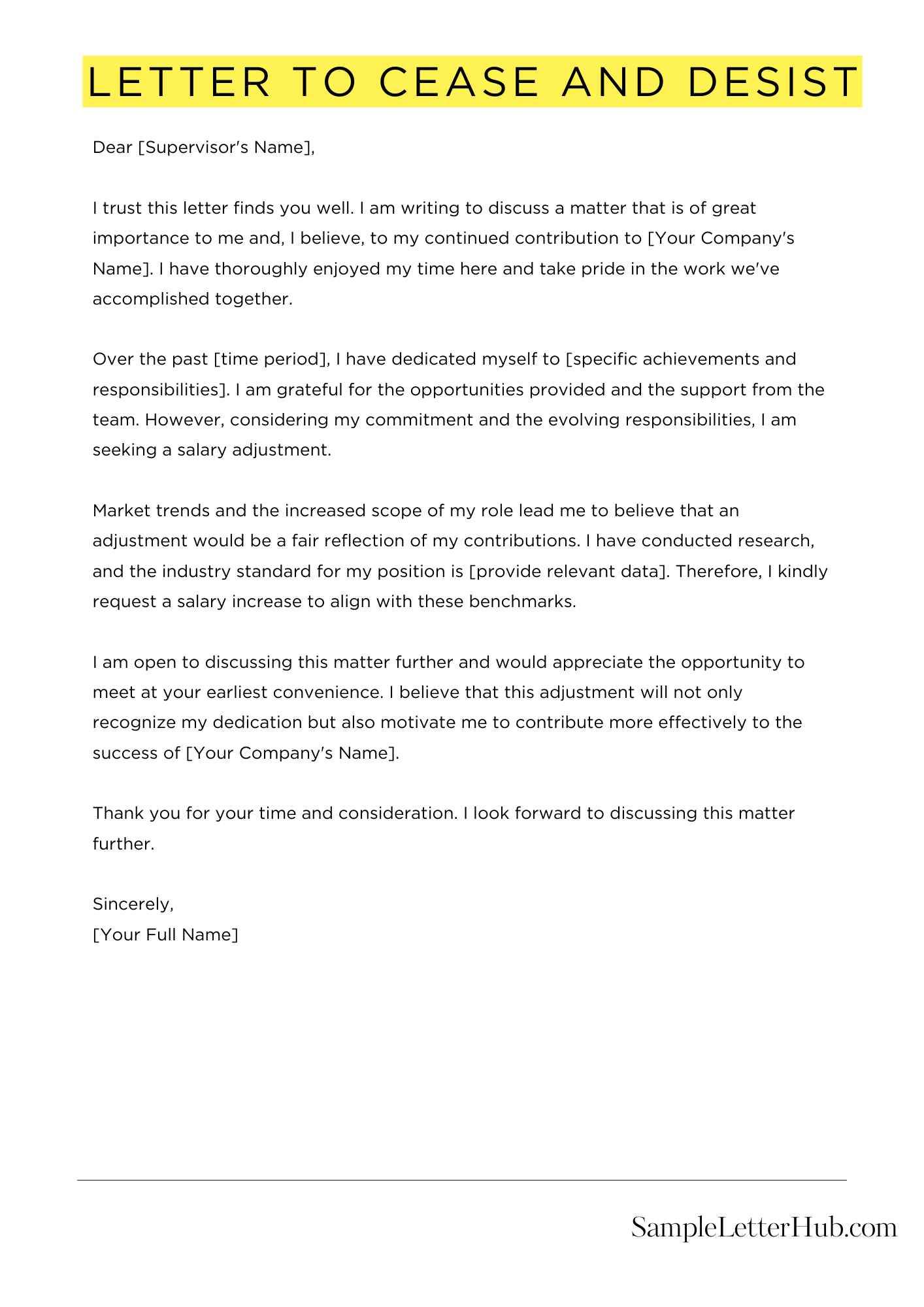A “Letter to Cease and Desist” is a formal letter that demands a person or entity to stop a specific action or behavior. It is a legal document that serves as a warning and can be used to protect your rights or interests.
In this blog post, we will provide you with templates, examples, and samples of “Letter to Cease and Desist” that you can use as a starting point for drafting your own letter. These templates and samples will cover various situations and can be easily customized to fit your specific needs.
Cease and Desist Letter
Dear [Recipient Name],
I am writing to demand that you immediately cease and desist from the following actions:
* [Describe the specific actions that you want the recipient to stop doing.]
These actions are causing me significant harm and are in violation of my legal rights. I have repeatedly requested that you stop these actions, but you have refused to comply.
If you do not cease and desist within [number] days of receiving this letter, I will have no choice but to take legal action against you. This could result in a court order requiring you to stop the offending actions, as well as damages for the harm that you have caused me.
I urge you to take this matter seriously and to comply with my demands immediately.
Sincerely,
[Your Name]

How to Write a Letter to Cease and Desist
A cease and desist letter is a formal demand that a person or entity stop engaging in a specific activity. These letters are often used to protect intellectual property rights, such as copyrights and trademarks, or to prevent defamation or other harmful conduct.
Essential Elements of a Cease and Desist Letter
- Identification of the Parties: Clearly identify the sender and the recipient of the letter.
- Description of the Infringing Activity: Specify the specific actions or conduct that is being demanded to cease.
- Legal Basis: State the legal basis for the demand, such as a copyright infringement or breach of contract.
- Demand for Cessation: Clearly state that the recipient must immediately stop the infringing activity.
- Consequences of Non-Compliance: Outline the potential legal consequences if the demand is not met, such as a lawsuit or injunction.
- Request for Response: Request a written response from the recipient within a specified timeframe.
- Signature: The letter should be signed by the sender or their authorized representative.
Crafting an Effective Cease and Desist Letter
To ensure the effectiveness of your cease and desist letter, consider the following tips:
- Be Specific and Detailed: Clearly describe the infringing activity and provide specific examples.
- Use Formal Language: Maintain a professional and respectful tone throughout the letter.
- Cite Legal Authority: Reference relevant laws or legal precedents to support your demand.
- Set a Reasonable Deadline: Allow the recipient sufficient time to respond and comply.
- Consider Legal Counsel: If the matter is complex or involves significant legal implications, consult with an attorney.
Consequences of Non-Compliance
If the recipient fails to comply with the cease and desist letter, the sender may pursue legal action. This could include filing a lawsuit for damages, obtaining an injunction to prevent further infringement, or seeking other appropriate remedies.
Conclusion
Writing a cease and desist letter can be an effective way to protect your rights and prevent harmful conduct. By following the essential elements and crafting an effective letter, you can increase the likelihood of achieving your desired outcome.
FAQs about Letter To Cease And Desist
What is a cease and desist letter?
A cease and desist letter is a legal document that demands that the recipient stop doing something. It is typically used to stop infringement of intellectual property rights, such as copyright or trademark infringement, or to stop other illegal activities, such as harassment or defamation.
When should I send a cease and desist letter?
You should send a cease and desist letter when you believe that someone is infringing on your legal rights. This could include using your copyrighted material without permission, using your trademark without permission, or engaging in other illegal activities that are causing you harm.
What should I include in a cease and desist letter?
A cease and desist letter should include the following information:
- A clear statement of the specific activity that you are demanding the recipient to stop.
- A statement of the legal basis for your demand, such as a citation to the relevant statute or case law.
- A demand that the recipient stop the activity immediately.
- A statement of the consequences if the recipient does not comply with your demand, such as a lawsuit.
What happens if the recipient does not comply with my cease and desist letter?
If the recipient does not comply with your cease and desist letter, you may have to take legal action to enforce your rights. This could include filing a lawsuit for copyright infringement, trademark infringement, or other legal claims.
How can I get help with writing a cease and desist letter?
If you need help with writing a cease and desist letter, you should consult with an attorney. An attorney can help you to ensure that your letter is legally sufficient and that it will be effective in stopping the recipient’s infringing activity.

